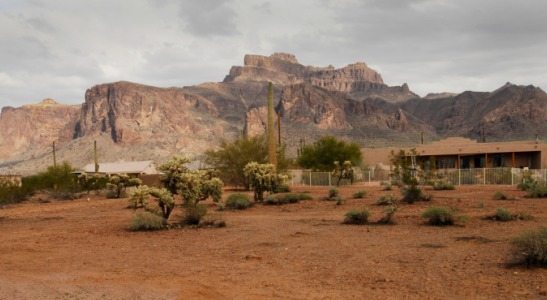Golf has played an important role in residential development in Arizona for years. Maybe it’s time the planners, developers and builders took a mulligan.
Superstition Vistas, a 275-square-mile area in northern Pinal County about 30 miles east of Phoenix, represents a chance for a sort of developmental “do over.”
If we knew then what we know now, would metropolitan Phoenix look different? Would, say, the western half of Mesa have more job centers? Would the downtowns of various municipalities be closer to the geographic center of each instead of at one end where the town first developed? Would our freeways and other transportation be routed differently?
With questions such as those in mind, a team of consultants has started developing models for Superstition Vistas that will guide the development of the area over the next 50 years or more. The area eventually is expected to be home to about 1 million people.
Except for one section — the area known as Lost Dutchman Heights, which was auctioned in December 2006 — the Arizona State Land Department owns the entire tract. Superstition Vistas is about as close to a blank canvas as it gets in the development game.
The consulting team will look at finding a better use for the land, better use of water and lowering emissions for greenhouse gases.
“We’re not really reinventing the wheel,’’ says Robert Grow, whose consulting firm will lead the research effort. “We’re trying to tap into knowledge that’s already there.”
At the heart of what Grow calls “the visioning process” is the idea of sustainability. There’s also an effort to make it easier for the Superstition Vistas residents to find a balance in their lives, to be able to “work, live and play” — as the current development catchphrase goes — without hopping in a car and taking it out on a freeway.
Grow’s team includes Harris Interactive, the well-known polling and research company from Rochester, N.Y.; EDAW, a San Francisco-based environmental and regional planning firm; Fregonese Associates, a Portland, Ore., land planning company; and Robert Charles Lesser & Co., based in Washington, D.C., which offers expertise in real estate strategic planning and market intelligence.
Grow is the head of Robert Grow Consulting in Salt Lake City. He has been involved in regional vision planing for more than 40 metro areas, including New Orleans after Hurricane Katrina.
Grow says all the firms were eager to participate, adding the project has the potential to show the world new ideas about how to make development work better with the environment.
“It’s unique,’’ he says. “There’s nothing like this that I know of.”
While Superstition Vistas may be larger than other master-planned communities, and its completion time frame longer, the concept is not new to Arizona.
“One difference is the others, such as McCormick Ranch, were mostly residential,’’ says Jay Butler, head of Arizona State University Polytechnic’s Realty Studies program.
One of the key elements behind Superstition Vistas is that jobs will be available for residents. Unfortunately, you can’t just build space and expect employers will come.
“It’s easier said than done,’’ Butler says. “You have to salt the mine a bit.”
Another challenge is to come up with a framework that will make sense economically, says Roc Arnett, president and CEO of the East Valley Partnership.
“It’s not just what people say they want but what they can afford and what they’ll buy,’’ he says.
Harris Interactive is spearheading efforts to ascertain what Arizona residents would like in an urban area. The consulting group is also creating a database about land use, water use and energy efficiency.
In May there will be an event involving the major stakeholders and the public. Grow stresses that the public will have input throughout the process.
The consulting team will eventually come up with scenarios for the steering committee. The steering committee is made up of the State Land Department, Pinal County, the town of Queen Creek, the cities of Apache Junction and Mesa, and others. Chuck Backus, the former provost at what is now Arizona State University Polytechnic, is chairman of the steering committee, which is facilitated by the East Valley Partnership and Pinal Partnership.
The municipalities that border Superstition Vistas have all made noise about making it part of their planning areas.
“I have asked everyone to stand down on any annexations until we come up with a plan,’’ says Mark Winkleman, the state land commissioner.
So it may be years before it’s decided whether Superstition Vistas is part of existing municipalities, its own city or some combination.
Since he came to the Land Department in 2003, Winkleman has been protective of Superstition Vistas. He has called the 176,000-acre area the most valuable asset of the more than 9 million acres the department oversees.
The department’s mission is to use the acreage set aside in a trust by the federal government in 1912 when Arizona became a state. Money generated through the land — by sale, lease or royalties — goes to fund K-12 education in Arizona and other state-supported entities.
In order to realize the full value of Superstition Vistas and ensure that any master plan is followed, Winkleman believes the department needs to operate with slightly different laws. He has pushed for reform to give the department flexibility in how it sells the land.
In 2006, there was a ballot measure that would have allowed that flexibility and created more oversight for the department. The Republican and Democratic parties, teachers, environmentalists and major news media backed the measure. Homebuilders and cattlemen backed a competing proposition. Voters rejected both measures.
“We’re operating under laws,’’ Winkleman says, “that were fine at the time of statehood.’’



